Thrips

Thrips do damage to the plant by using their jagged mouths to scrape the surface of the plant, thus causing the plant's vital juices to become more easily accessible for the thrips. Because of the damage from scraping, the leaves will show white and yellow spots with possible silver scrapes. The thrips also leave behind a series of small black spots on the plant from their feces. Because the plant cannot recover from this leaf damage, the plant will not be able to absorb enough light and will die if the thrips are not controlled.
Treatment of thrips involves attacking both the adult thrips and the pupae. Thrips inject eggs into the the structure of the leaves themselves. Once the eggs hatch, the pupae fall into the medium at the base of the plant and finish developing there. To stop this development you can try spreading a layer of diatomaceous earth or weed killing mulch on the top layer of soil. A collar made of aluminum foil or newspaper can be placed at the base of the plant to help deter pupae from surviving. For treatment of adults try beneficial nematodes, predatory lacewigs, predatory mites, insecticidal soap, neem oil, pyrethrum, or cinnamon oil.
